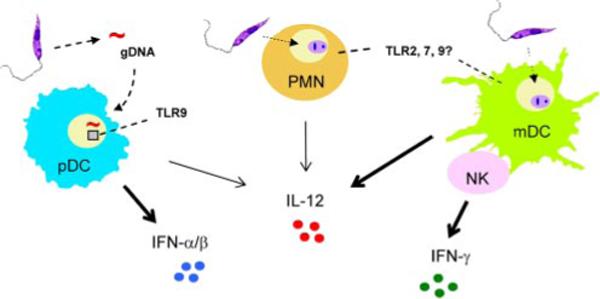FIGURE 1.

A schematic view of the hierarchy within different cell types, receptors, and cytokines in activating innate and adaptive immunity at the initial stages of infection with Leishmania promastigotes. Following the initial infection with Leishmania promastigotes, PMNs are recruited within hours to the site of infection and constitute the majority of the cellular infiltrates in the first day of infection. Parasite infection in PMNs may trigger the expression of TLR2, 7, and 9, as well as the production of some IL-12. Although pDCs do not endocytose promastigotes, they can be activated via released Leishmania genomic DNA (gDNA) to produce appreciable amounts of IFN-αβ and some IL-12 in a TLR9-dependent manner. mDCs and monocyte-derived DCs can efficiently engulf promastigotes, serving as a critical source of early IL-12 production. Activated DCs can migrate to draining LNs, activate resting NK cells via cell contact-dependent manner, and trigger NK cells to produce IFN-γ. The cognate interactions among multiple innate cell types and cytokines at the site of infection and in draining LNs are required for appropriate activation of protective Th1 responses against the invading pathogens. However, the magnitude of DC and Th1 cell activation in vivo varies greatly, depending upon the species of parasites involved.
